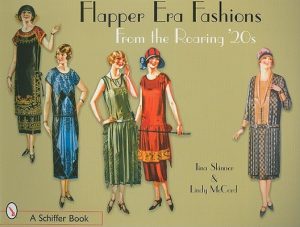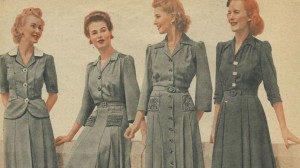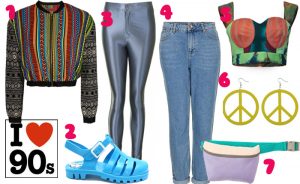20TH CENTURY FASHION
This era is particularly famous as a variety of designs, styles and materials of other cultures and times became accessible to designers. Talking about accessibility, first hand communication along with travel was made easy between continents. Secondary sources such as magazines, books and journals lead to developments in printing techniques and photography to name a few.
 |
| Fig: Evolution of dresses over the years |
Talking about the early 20th century, (1900s) historical and multi-cultural sources are evident. The popular figure- Silhouette i.e. pigeon berated bosom with a tiny waist and swayback hips became highly famous. Skirts swept the floor and evening gowns with low necks were popular among the women. Wide picture hats ruled this decade. In fabrics- natural fibbers like linen, cotton, wool and silk were preferred. And popular colours included shades of black and brown, white or embroidered polka dots.
With the progression of the decade, (1910s) hats narrowed down. Horizontal layered appearance- in skirts or tailored jackets was the new “in thing”. A new addition to the fabrics was rayon - artificial silk. One example is Chanel ; which used denim as a leisure fabric even before denim became popular in this period. Small figure prints with solid colours in the day and exotic vibrant hues in the evening became well known. The highlights were the fur, tassels and feathers which were the new “mystique look of fashion”.
 |
| Fig: Fashion from the 2o's |
In 1920s and 30s, for the first time, the slim and natural silhouette became the style. Hair was shoulder length- waved. 20s were popular for simplified and elongated lines. fabrics included crepes and chiffon and colours preferred were small checks or a floral pattern. Whereas 30s were popular for their medieval or ultra-Deco touch. Use of linen sometimes along with velvet in geometric and abstract prints was a hit! Fads and innovations included smoking in public, obvious makeup, extreme dieting, tanned skin, first appearance of midriff, use of costume jewellery and platform heels to name a few.
In 1940s, broad chests and shoulder pads became a must. Hair was shoulder length or longer- curled. Common designs included fitted jackets and skirt suits - mostly in nylon which was the sole material in some sheer day dresses. Casual clothes were sometimes boldly coloured. 1950s silhouettes were a hallmark because of the soft but wide shoulders, corseted waist and full hips. One particular style that literally hid all the rest was the cocoon inspired sacque dress and coat. Modelling as a job, cat eye glasses and hawaiian shirts became some fads.
 |
| Fig: Short hair and slimmed waistlines |
1960s to 1990s fashion celebrated scientific progress and modernity. However, when it comes to the shape of womenswear in 60s, it can be traced back to the 20s inspire of all the use of space age imagery and use of new materials. Full skirt dresses from the 70s with matching turbans reflects the gentle ethnic influence. After this punk, the pirate outfit- tunic top, sash, waist coat, trousers, hat and heavy boots from the 80s draws on a variety of historical and cultural sources. The 90s dress ‘Rhythm Pleats” is reminiscent of Fortuny. However, rather than clinging onto the body, the hi0tech polyester and linen mix garment formed an angular and sculptural shape on the body.
 |
| Fig: Age of technology ; street fashion |
No comments:
Post a Comment